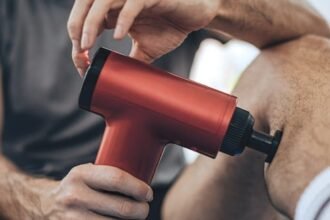Are you ready to take charge of your birthing experience? As an expectant mother, I’ve found a technique that could change everything. Perineal massage is simple yet powerful. It’s worth considering, but what is it exactly?
Perineal massage prepares the area between your vagina and anus for childbirth. It gently stretches these tissues to lower the risk of tearing. Since 85% of women face perineal trauma during vaginal birth, mastering this massage could be key.
In this guide, I’ll show you how to do perineal massage right. We’ll look at its benefits and share tips for effective practice. Whether you’re having your first baby or your next, this info could make your birthing experience smoother.
Key Takeaways
- Perineal massage helps prepare the perineum for childbirth
- It can reduce the risk of perineal trauma during delivery
- 85% of women experience perineal trauma during vaginal birth
- Proper technique is crucial for effective perineal massage
- Regular practice in the third trimester can yield the best results
Understanding Perineal Massage and Its Benefits
Perineal massage during pregnancy is a helpful technique. It prepares your body for childbirth. I’ll explain what it is, its benefits, and how it can reduce the risk of perineal trauma.
What is perineal massage?
Perineal massage involves gently stretching and massaging the perineum. This area is between the vagina and anus. It helps make the tissues more elastic, getting ready for childbirth.
Benefits of perineal massage during pregnancy
Regular perineal massage has many benefits for expectant mothers:
- Increased flexibility of perineal tissues
- Improved blood circulation to the area
- Reduced anxiety about the birthing process
- Enhanced awareness of your body
Reducing the risk of perineal trauma
One main reason for perineal massage is to prevent tearing. Studies show that regular massage from 35 weeks of pregnancy can lower the risk of severe tearing. It also reduces the need for episiotomies, especially for first-time mothers.
| Outcome | With Perineal Massage | Without Perineal Massage |
|---|---|---|
| Risk of severe tearing | Reduced by up to 16% | Higher risk |
| Need for episiotomy | Decreased by up to 12% | More frequent |
| Perineal pain postpartum | Less common | More common |
When to Start Perineal Massage

Many people wonder when the best time is to start perineal massage during pregnancy. Experts say to start at 35 weeks. This gives you enough time to practice before the baby arrives, without risking any harm.
It’s recommended to do perineal massage 3-4 times a week. Each session should last about 3-4 minutes. This helps get the perineal area ready for the stretching that happens during childbirth.
While 35 weeks is the usual start time, some women might want to start earlier. It’s important to listen to your body and talk to your healthcare provider before starting.
“Every pregnancy is unique. What works for one woman may not work for another. Always consult your doctor before starting any new routine during pregnancy.”
There are times when you should not do perineal massage:
- Vaginal infections
- Thrush
- Genital herpes outbreaks
If you’re not sure when to start or have concerns, talk to your healthcare provider. They can give you advice that fits your specific needs and health history.
| Perineal Massage Schedule | Recommendation |
|---|---|
| Start Date | 35 weeks of pregnancy |
| Frequency | 3-4 times per week |
| Duration per Session | 3-4 minutes |
| Total Weeks of Practice | 5-6 weeks before due date |
Preparing for Your First Perineal Massage Session
Getting ready for your first perineal massage is a big step in your pregnancy. I’ll show you how to prepare for a smooth and comfortable experience.
Gathering Necessary Supplies
First, gather these items for your massage:
- Unscented lubricant or natural oils (vitamin E, almond, or olive oil)
- Clean towels
- A small mirror (optional)
- Comfortable pillows for support
Creating a Comfortable Environment
Make a cozy space for your massage:
- Find a quiet spot where you won’t be interrupted
- Use pillows to support your back and legs
- Dim the lights and play calming music if you like
- Keep the room warm to help you relax
Proper Hand Hygiene
Cleanliness is key for your massage:
- Wash your hands well with soap and warm water
- Trim your fingernails to avoid scratching
- Wear latex gloves if you prefer
For the best results, do your massage after a warm bath or shower. This makes your perineum softer and easier to massage. Follow these steps to set up a great space for your massage.
| Preparation Step | Importance | Tips |
|---|---|---|
| Gathering Supplies | Ensures smooth massage experience | Choose high-quality, unscented products |
| Creating Comfort | Promotes relaxation and effectiveness | Experiment with different positions and supports |
| Hand Hygiene | Prevents infection and irritation | Use warm water for a more comfortable start |
How to Do Perineal Massage

Learning perineal massage techniques is key for expecting moms. I’ll show you how to do it step by step. This way, you’ll know how to massage your perineum effectively.
Step-by-Step Guide
First, get into a comfy position. Then, apply oil to your perineum. Next, insert your thumbs about 2.5cm inside your vagina.
Press down and to the sides, holding for 1-2 minutes. This helps stretch the tissues.
Proper Technique and Pressure
Use a U-shaped movement to massage the lower vagina for 2-3 minutes. Try to relax your perineum and breathe deeply. The pressure should be firm but not too hard.
If it hurts, ease off the pressure.
Duration and Frequency
Do the massage 2-3 times a session. Try to do it every day for about 10 minutes. Being consistent is important.
| Aspect | Recommendation |
|---|---|
| Session Duration | 10 minutes |
| Frequency | Daily |
| Pressure | Firm but comfortable |
| Movement | U-shaped |
By using these techniques, you can get your body ready for childbirth. It might also help reduce tearing during delivery.
Perineal Massage Techniques for Self-Application

Learning to do perineal massage at home can be empowering. I’ll show you some effective techniques to try on your own.
Start by finding a comfy position. You might like sitting with pillows, reclining in a warm bath, or standing in the shower. Choose a spot where you’re relaxed and can easily reach your perineum.
To start the massage, use your thumbs. Gently push them 1 to 1.5 inches into your vagina. Use soft pressure downwards and to the sides. Hold this stretch for 60 to 120 seconds. Breathe deeply and relax your pelvic floor muscles.
Then, try a U-shaped movement. Massage the lower part of your vagina in a U shape for 2 to 3 minutes. This helps increase the area’s elasticity.
| Technique | Duration | Benefits |
|---|---|---|
| Thumb Stretch | 1-2 minutes | Increases perineal flexibility |
| U-Shape Massage | 2-3 minutes | Enhances tissue elasticity |
| Deep Breathing | Throughout session | Promotes relaxation |
Regularly practice these perineal massage techniques. Over time, you’ll get more comfortable and ready for a smoother birthing experience.
Partner-Assisted Perineal Massage
Partner-assisted perineal massage is a great way to get ready for childbirth. It’s more comfortable and effective when you have a partner, especially in the later stages of pregnancy.
Communication and Comfort
Talking openly is important when doing partner-assisted perineal massage. Make sure to discuss it with your partner before starting. It’s also key to create a relaxed atmosphere for a good experience.
Partner Techniques
Here’s a good method for partner-assisted perineal massage:
- Use index and middle fingers instead of thumbs
- Insert fingers into the vagina up to the second knuckle
- Perform a U-shaped massage for a few minutes
- Let the pregnant woman guide the pressure and duration
Positioning for Partner-Assisted Massage
The semi-upright position on a bed or sofa is the most comfortable. It allows easy access and helps the pregnant woman relax. Remember, comfort is the most important thing during this practice.
Adding partner-assisted perineal massage to your routine can improve its benefits. It strengthens the bond between partners and makes the process more enjoyable and effective.
Best Oils and Lubricants for Perineal Massage
Choosing the right perineal massage oil is key when getting ready for massage. The right lubricant can greatly improve comfort and results. Let’s look at some top picks for this prenatal practice.
Unscented personal lubricants are a favorite for their smooth feel and safe for most skin types. Vitamin E oil is also great, as it helps nourish the skin. Many moms-to-be use natural oils like almond or olive oil for their massage.
For a more specialized option, there are oils made just for pregnancy. These oils often mix essential oils to help stretch the skin and protect it.
| Oil Type | Benefits | Considerations |
|---|---|---|
| Unscented Lubricant | Hypoallergenic, smooth texture | May need frequent reapplication |
| Vitamin E Oil | Nourishes skin, promotes healing | Can be sticky, may stain clothes |
| Almond Oil | Natural, light texture | Avoid if nut allergies present |
| Olive Oil | Readily available, moisturizing | Strong scent, may feel greasy |
| Specialized Perineal Oil | Formulated for pregnancy, promotes elasticity | More expensive, may contain allergens |
When picking a perineal massage oil, safety and comfort should be your top priorities. Make sure the product is safe for pregnant women and doesn’t irritate the skin. If you’re not sure, talk to your healthcare provider before starting your massage routine.
Common Concerns and Troubleshooting
I know perineal massage during pregnancy can bring up questions and worries. Let’s tackle some common issues and find solutions for a smooth experience.
Dealing with Discomfort
Perineal massage instructions say it shouldn’t hurt. If you feel discomfort, here are some tips:
- Use more lubricant
- Apply gentler pressure
- Take deep breaths to relax
- Try different positions
If the pain doesn’t go away, stop and talk to your healthcare provider.
When to Avoid Perineal Massage
There are times when you shouldn’t do perineal massage during pregnancy:
| Condition | Reason to Avoid |
|---|---|
| Vaginal infections | Risk of spreading infection |
| Thrush | Can worsen symptoms |
| Genital herpes outbreak | May cause virus to spread |
| Placenta previa | Risk of bleeding |
Addressing Sensitivity Issues
If you’re feeling sensitive, try these changes:
- Reduce pressure
- Shorten massage duration
- Use a different oil or lubricant
- Practice relaxation techniques before starting
Remember, perineal massage gets better with practice. If worries keep up, don’t hesitate to ask your midwife or doctor for help and support.
Additional Tips for Protecting Your Perineum During Birth
Perineal massage for labor is a great way to get ready. But, there are more ways to keep your perineum safe during birth. Here are some important tips to help you avoid tearing and make your birthing experience better.
First, don’t push too hard or hold your breath. Push gently when you feel like it. This lets your body work naturally and puts less pressure on your perineum.
The position you’re in during birth matters a lot. Being upright or on your side is better than lying on your back. These positions can help lower the pressure on your perineum and make the birth easier.
Using a warm compress on your perineum during labor can be very comforting. It makes blood vessels wider and keeps your skin moist. This might help prevent tearing.
Try hypnobirthing techniques. These methods help you relax and breathe your baby down, especially when they’re crowning. This gentle way goes well with perineal massage to prevent tearing.
| Tip | Benefit |
|---|---|
| Gentle pushing | Reduces strain on perineum |
| Upright or side-lying positions | Decreases perineal pressure |
| Warm compress | Enhances skin elasticity |
| Hypnobirthing techniques | Promotes relaxation and gentler delivery |
By using these tips and doing regular perineal massage, you’re taking good care of your perineum. This can make your birthing process easier.
Conclusion
I’ve shared valuable insights about perineal massage during pregnancy. This technique offers many benefits, especially for first-time moms. It can lower the risk of tearing and ease discomfort after birth.
Starting perineal massage at 34-35 weeks is ideal. You can do it alone or with a partner’s help. Use gentle pressure and the right oils. Make it a regular part of your pre-birth routine for the best results.
Perineal massage is just one tool in your birth prep toolkit. Pair it with good birthing positions and controlled pushing. Together, these methods can lead to better outcomes and faster healing. As you near your due date, give perineal massage a try. It might just make a big difference in your birth experience.
FAQ
What is perineal massage?
What are the benefits of perineal massage during pregnancy?
When should I start perineal massage?
How do I gather necessary supplies for perineal massage?
How do I perform perineal massage?
Can my partner assist with perineal massage?
What oils or lubricants are best for perineal massage?
What if perineal massage is uncomfortable or painful?
Are there any additional tips for protecting the perineum during birth?
Source Links
- How to do perineal massage: a step-by-step guide | Pregnancy, Worries and discomforts articles & support | NCT – https://www.nct.org.uk/pregnancy/worries-and-discomforts/common-discomforts/how-do-perineal-massage-step-step-guide
- Childbirth: Perineal Massage Before Labour – https://myhealth.alberta.ca/Health/pages/conditions.aspx?hwid=tn10339
- How To Do Perineal Massage To Prevent Perineum Tearing – https://myexpertmidwife.com/blogs/my-expert-midwife/why-you-should-do-perineal-massage-and-how-to-do-it













8 Comments
Interesting read, but can we talk about the difficulty of self-performing perineal massages during late pregnancy stages? Any practical solutions?
Interesting read! Ever wonder if perineal massage techniques vary between different cultures? Any research on that?
Interesting point, but isnt cultural variation in any technique inevitable? Food for thought!
Interesting read! But is there any scientific evidence backing up the benefits of perineal massage during pregnancy?
Interesting read! Do you think incorporating essential oils could enhance the benefits of perineal massage?
Essential oils? Not everything needs to be enhanced. Stick to the basics!
Is there any scientific evidence that perineal massage reduces postpartum recovery time? Just curious, not doubting the practice.
Actually, studies have shown it primarily reduces risk of tearing, not recovery time!